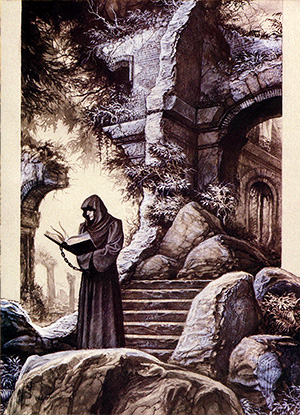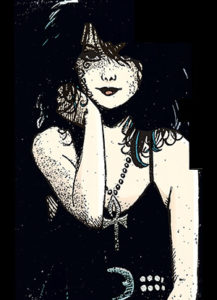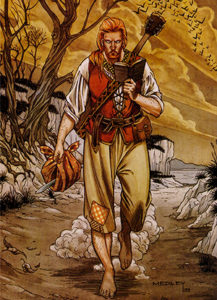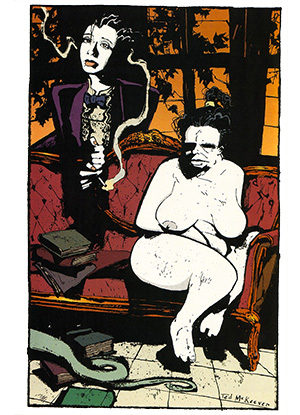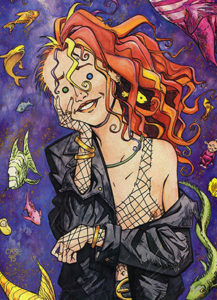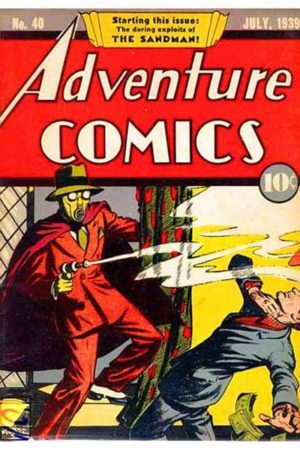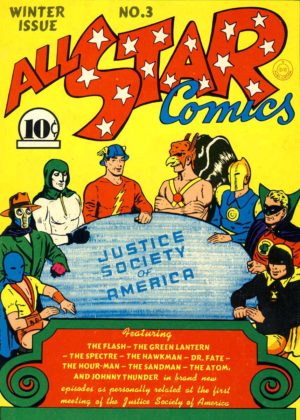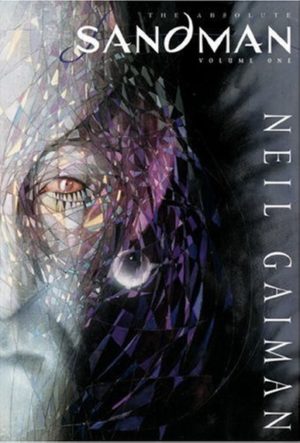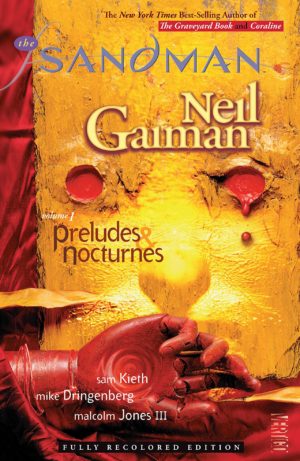The Sandman and The Dreaming comic books definitive issue-by-issue collecting guide and trade reading order for omnibus, hardcover, and trade paperback collections. Find every issue and appearance! Part of Crushing Krisis’s Crushing Comics. Last updated June 2024 with titles scheduled for release through September 2024.
Want to get straight to reading Neil Gaiman’s legendary 75-issue Sandman series? It’s one of the most comprehensively collected runs of the past 40 years of comics, and you have plenty of format options – all explained in full below!
- Absolute Editions
- Omnibus Editions
- Deluxe Hardcover Editions
- Paperback Re-Collections
- The original 10 Hardcover & Paperback Editions by story arc
- Annotated Editions (and other academically-oriented collections)
Read on for a history not only of Gaiman’s Sandman, but all of DC’s many Sandmen as well as the entire universe of comics that sprung from Gaiman’s work.
The Sandman is both a somewhat obscure Golden Age hero revived by the Justice Society for modern audiences and one of the most widely-read characters in the history of American comics.
They are not the same character.
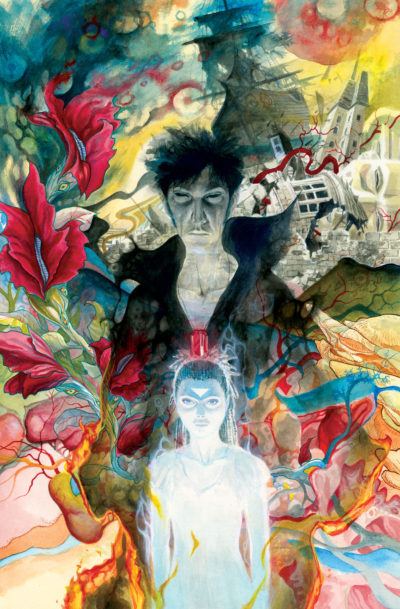
The Golden Age Sandman was Wesley Dodds. Dodds was an odd early take on superheroism, dressing in a sharp green three-piece suit and subduing foes with a gun that fired gas that could compel them to tell the truth or put them to sleep.
Dodds was one of many Golden Age Justice Society characters to stay constrained to DC’s vintage Earth 2 with no Silver Age (AKA Earth 1) counterpart – although Jack Kirby and Joe Simon did briefly reinvent The Sandman in 1974 with a new character, Garrett Sanford.
In the wake of Crisis on Infinite Earths, DC could have easily reinvented either Dodds or Sanford for their new clean slate of continuity. Instead, they handed the character to a barely-known British journalist: Neil Gaiman.
Gaiman had very little work to his name at that point, including the Mostly Harmless biography of Douglas Adams and a handful of issues of 2000 AD. However, he had successfully pitched DC on a three-issue series called Black Orchid in 1988. The series didn’t sell much, but it was well-liked by editor Karen Berger. It was on the heels of that mild success that he pitched his re-imagination of Sandman.
In fact, Gaiman originally intended to reference the 1970s Sandman in Black Orchid, and so his initial Sandman pitch was for that version of the character. Berger, Vertigo’s founding editor, asked him to re-pitch Sandman as a new character. In response Gaiman devised Morpheus, one of the seven eternal Endless – immutable forces of the natural world.
They rest, as they say, is history.
Sandman wasn’t an immediate pop culture force, but it caught on quickly. The first issue was popular, and sales began to climb with issue #5 and never looked back. Morpheus appeared in the other proto-Vertigo titles in Swamp Thing #84 and Hellblazer #19. Later, Gaiman began to incorporate the history of the Golden and Bronze age Sandmen into his story.
The title achieved its cultural impact by degrees over the course of the next three years until The Sandman (and Neil Gaiman, along with it) reached a tipping point and broke through into the consciousness of the wider public.
In 1990, Gaiman penned The Books of Magic mini-series for Vertigo. This self-contained low fantasy story, to which Harry Potter bears a more-than-striking similarity, proved to be a massive hit that spawned its own franchise of titles (visit the guide). Shortly before that, Gaiman and Terry Prachett released the novel Good Omens. Prachett was much more famous than the neophyte Gaiman (it was his first novel), and the book was popular.
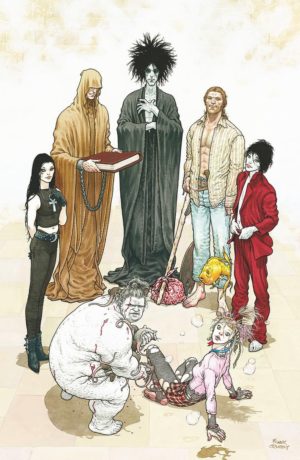
Books garnered critical attention and Omens nabbed some significant fantasy award nominations in 1991. Perhaps uncoincidentally, so did Sandman. Issue #19, a loose adaption of A Midsummer Night’s Dream, won the World Fantasy Award in 1991 for “Best Short Fiction” (after which comics were outlawed from winning in that category).
Also in 1990, DC published the Sandman trade paperback – A Doll’s House – which originally collected issues #8 (Death’s debut) through #16. It was a massive success, and DC followed it with Preludes and Nocturnes in 1991 just as Sandman won the World Fantasy Award.
The trade paperbacks were available in traditional bookstores, where the series was discovered by audiences that the comic alone would never be able to reach. This, along with Watchmen and several of DC’s famous Batman graphic novels, were effectively the origin story of the modern American trade paperback format.
Finally, in the first week of 1992, Tori Amos’s Little Earthquakes was released. Its track “Tear In Your Hand” saying, “If you need me, me and Neil’ll be hanging out with The Dream King.”
Amos’s music garnered a cult following with literary-minded freaks and geeks on the fringes of grunge culture. As her audience devoured the dense mythology of her confessional and sometimes-fantastical lyrics, they stumbled upon Gaiman’s Sandman – as well as his pair of Death mini-series in the early 90s. Amos penned the introduction to the collection of The High Cost of Living. This brought even more fans from outside of the worlds of comics and fantasy to Gaiman’s work.
From that point forward, The Sandman was an unstoppable juggernaut of critical praise and sales … right up until Gaiman stopped it, in March of 1996 with issue #75. It ended while still outselling most of the DC line, including comics from Batman and Superman.
Gaiman had long seeded his narrative with hints of Morpheus’s end, though that didn’t necessarily mean that Sandman itself would end along with him. The end of Sandman lead to a trio of spinoffs – a second Death mini series (The Time of Your Life), a mini-series for Destiny (A Chronicle of Deaths Foretold), and the ongoing comic The Dreaming depicting the ongoing life of the dreamworld after Morpheus’s depature.
The Dreaming ran for five years, though it was never a hit on the magnitude Sandman itself. Yet, its endurance allowed for the launch of several mini-series – some under the title “The Sandman Presents.” One of those mini-series starred Gaiman’s version of Lucifer as penned by Mike Carey, which spun into its own franchise with a 75-issue series in 2000 and a later 2016 revival (visit the guide).
While the character of Sandman is wholly-owned by DC, they have always shown Gaiman an extraordinary amount of deference in their use of the universe and its characters (as opposed to, say, their treatment of Alan Moore). DC continued to release titles in this extended Sandman Universe through 2014, always with Gaiman’s consent but rarely with him writing, save for Dream Hunters and Endless Nights. That changed in 2013, when Gaiman returned not only to his Sandman Universe, but to Morpheus himself with The Sandman Overture. Overture was a tale of Morpheus’s journey prior to The Sandman #1 with lush illustrations from JH Williams and Dave Stewart.
After a several years break from any Sandman Universe stories save for Lucifer, Dream made a surprising appearance in the 2017-18 line-wide event Metal as a sort of ephemeral shepherd to Bruce Wayne. While not directly linked to the events of Metal, Dream’s appearance there can be seen as a prelude to the 2018 relaunch of the Sandman Universe as its own self-contained line of Vertigo titles beginning with The Dreaming, House of Whisper, and relaunches of Lucifer and Books of Magic.
Interested in learning about the history of Neil Gaiman’s Sandman, including only characters and titles written by or directly supervised by Gaiman? Here’s the abbreviated table of contents for you:
- The Sandmen
- The Endless
- Golden Age Sandman: Wesley Dodds
- Sandman Mystery Theatre (1993) #1-70 & Annual 1 (April 1993 – Feb 1999)
& Sandman Midnight Theatre (August 1995) - Wesley Dodds: The Sandman (2023) #1-6
- Sandman Mystery Theatre: Sleep of Reason (2007)
- Sandman Mystery Theatre (1993) #1-70 & Annual 1 (April 1993 – Feb 1999)
- Neil Gaiman’s Sandman, Dream of the Endless
- The Sandman (1989) #1-75
- Sandman Special: The Song of Orpheus (1991)
- The Sandman: A Gallery Of Dreams (1994) #1
- The Endless Gallery #1 (1995)
- Sandman Midnight Theatre (August 1995)
- The Sandman: Book of Dreams (1996)
- The Sandman: The Dream Hunters OGN (1999)
& The Sandman: Dream Hunters (2009) #1-4 - The Sandman: Endless Nights OGN (2003)
- The Sandman: Overture (2013) #1-6
- The Sandman (1989) #1-75
- Neil Gaiman’s Death of the Endless
- Death: The High Cost of Living (1993) #1-3
& Death Talks About Life (1994) - Death: The Time of Your Life (1996) #1-3
- Death: The High Cost of Living (1993) #1-3
- The Extended Sandman Universe (1988 – 2017)
- Black Orchid (1988) #1-3
- The Dreaming (1996) #1-60 (June 1996 – May 2001)
& The Dreaming: Trial and Error Special
- The Sandman Universe (2018 – present)
- The Dreaming (2018)
- The Dreaming: Waking Hours (2020)
- The Dead Boy Detectives (2022) #1-6
- Nightmare Country
- Sandman Universe: Nightmare Country (2022) #1-6,
- The Sandman Universe Special: Thessaly (2023) #1
- The Sandman Universe: Nightmare Country, The Glass House (2023) #1-6
Want to dig in to everything Sandman? It’s all covered in this guide! Click for the extended table of contents, which lists every series every associated with Sandman!
Patreons make this page possible! Every month, Patrons of Crushing Krisis help to fund its hosting, helper applications, video production, and more! Every dollar contributed by Patrons goes directly to helping sustain and grow this site.
Join the Crushing On Crushing Krisis mailing list for a notice whenever this page is updated with new collections – plus, a infrequent ping about new comics content.
The Sandmen
You don’t need to do any pre-reading to appreciate Neil Gaiman’s Sandman. You’re meant to start at the start with zero foreknowledge of the character and the DC Universe!
However, if you want to know more about how Sandman came to be and how Neil Gaiman wove him into the existing DC Universe, read on for an explanation of the four main Sandmen of the DC Universe.
Golden Age Sandman, Wesley Dodds
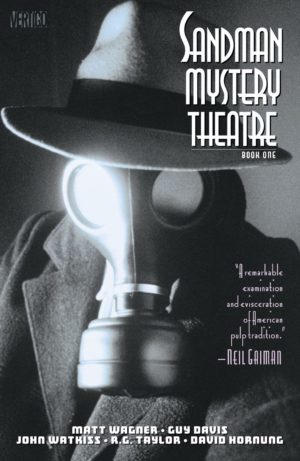
Wesley Dodds is a Golden Age (1930s-50s) detective and inventor who dreams of future crimes. He debuted in the pages of Adventure Comics (1939). He is equipped with a gas mask and his “Silicoid Gun,” which emits a sleep gas of his own invention.
Dodds begins his adventures in a period where Gaiman’s Dream is unable to carry out his Sandman duties. Gaiman and others establish as a piece of retroactive-continuity (retcon) that Dream’s absence gives Dodds a slight connection to the supernatural.
Dodds lived beyond the Golden Age as one of the members of the Earth 2 Justice Society from the Silver Age (1960s) and forward. Sandman Mystery Theatre, a Vertigo Comics spinoff that was contemporaneous to Gaiman’s The Sandman, told flashback stories set prior to his Golden Age origin.
Wesley Dodds and his full list of appearances in continuity through Crisis on Infinite Earths are detailed below.
Bronze Age Sandman, Garrett Sanford
This second Sandman was introduced as the actual Sandman, he of “Mister Sandman, bring me a dream.”
However, that origin was quickly retconned in one of his few further appearances in Wonder Woman (1942) #300. There, we discover he was a professor named Garrett Sanford who became trapped in the dream dimension AKA “The Dreaming.” His full appearances are detailed below.
While Gaiman would not use him directly, he did make his one-time Justice League foe Dr. Destiny into the first true villain of Sandman in issues #2-7. He also adopted Sandford’s pair of sidekicks, Brute and Glob, who appear a handful of times in Gaiman’s run.
Neil Gaiman’s Sandman – Morpheus, Dream of The Endless
Generally, when comic fans refer to “Sandman” – and especially to “The Sandman” – they mean Morpheus, Neil Gaiman’s signature creation as introduced in The Sandman (1989) #1. Morpheus is one of The Endless, who are covered in the next section. While he is ostensibly eternal, he is not immortal.
Morpheus very rarely has been written by anyone other than Gaiman, and always with Gaiman’s explicit approval. His full appearances are detailed below.
Daniel Hall, The Dream King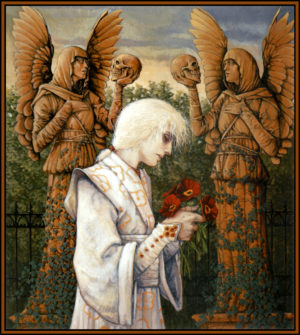
Daniel Hall is the son of a pair of DC characters that predate Gaiman’s Sandman – the Justice Society’s Fury AKA Lyta Hall and her husband Hector Hall (AKA Silver Scarab, Dr. Fate, and briefly another iteration of Sandman).
In fact, Lyta Hall can be seen to be pregnant with Daniel in Infinity, Inc. #42 in 1987 – prior to the debut of Gaiman’s book!
Daniel appears several times in Sandman as a human, mostly in The Kindly Ones story. He’s in issues #22, 40, 47, 57, 59, 61, and 65-69.
At the end of Gaiman’s run of Sandman, Daniel appears as a new version of Dream in #69-72 & 74. After that, he makes a finite amount of appearances in both the Vertigo and DC universes through the introduction of the renewed “Sandman Universe” in 2018.
Daniel Hall appears in The Books of Magic (1994) #13, 21, & 75, The Dreaming (1996) #29(?), 35(?), 38(?) 43, 49(?), 58-60, & Special #1, JLA (1997) #22-23, JSA (1999) #1, 63, & 80, Planetary (1999) #7, The Sandman Presents: The Furies (2002), Lucifer: Nirvana (2002), The Sandman: Endless Nights (2003), The Sandman: Overture (2013) #2 & 6, and Dark Nights: Metal (2017) #1-2 & 4.
He is the focal point (though not the star) of the revived The Dreaming as part of the relaunched Sandman Universe in 2018.
The Endless
The Endless were introduced by Neil Gaiman in The Sandman, though one of them was a pre-existing character. They are a group of seven siblings that are the embodiment of eternal, everlasting aspects of life, the universe, and everything – the eternal family of Destiny, Death, Dream, Destruction, Desire, Despair, and Delirium. Morpheus is the third-eldest of the siblings.
Want a primer on each of The Endless, plus a full list of their appearances? Click for introductions to The Endless, including their appearances outside of Sandman.
![]()
Golden Age Sandman, Wesley Dodds
While Wesley Dodds is no immortal deity, he does have a minor aspect of Morpheus’s powers. He starred in his own featured stories in Adventure Comics (1939) until 1946, at which point he disappeared from DC continuity for 20 years. He was also a founding member of the Justice Society of America in All-Star Comics (1940).
Sandman Mystery Theatre (1993) #1-70 & Annual 1 (April 1993 – Feb 1999)
& Sandman Midnight Theatre (August 1995)
This Vertigo series launched by Matt Wagner in 1993 is generally set prior to Wesley Dodds joining the Justice Society of America, which was formed in All-Star Comics (1940) #3.
in a 2023 paperback compendium line…
#1-26 & Annual 1: The Sandman Mystery Theatre Compendium One (2023 paperback, ISBN 978-1779521538)
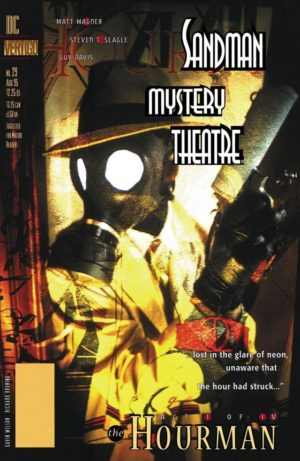
in a 2016 reprint line…
#1-12: Book 1 (2016 paperback)
#13-24 & Annual 1: Book 2 (2017 paperback)
#25-70: Not collected in this format
as originally collected…
#1-4: Vol. 1: The Tarantula (1995 paperback, ISBN 9781563891953)
A retelling of Wesley Dodd’s first appearance in Adventure Comics (1938) #40.
#5-12: Vol. 2: The Face and The Brute (2004 paperback)
#13-16: Vol. 3: The Vamp
#17-20: Vol. 4: The Scorpion (2006 paperback)
Annual 1: Not collected
#21-28: Vol. 5: Dr. Death and The Night of the Butcher
#29-36: Vol. 6: The Hourman and The Python
Sandman Midnight Theatre OGN (1995)
Also collected in Absolute Sandman, Vol. 5 and The Sandman Omnibus, Vol. 3
#37-44: Vol. 7: The Mist and The Phantom of the Fair
#45-52: Vol. 8: The Blackhawk and The Return of the Scarlet Ghost
#53-56: Not collected; “The Crone”
#57-60: Not collected; “The Cannon”
#61-64: Not collected; “The City”
#65-68: Not collected; “The Goblin”
#69-70: Not collected; “The Hero”
Dream States: The Collected Dreaming, Sandman Presents and Overture Covers 1997-2014
Click to continue to a list of Wesley Dodds\' Golden Age appearances.Wesley Dodds: The Sandman (2023) #1-6
Written by Robert Venditti with art by Riley Rossmo.
#1-6: Wesley Dodds: The Sandman (2024 paperback, ISBN / digital TBA)
Wesley Dodds, The Sandman
in Earth 2 Justice Society of America and All-Star Squadron
Wesley Dodds returns to continuity in Justice League of America (1960) #46. This is “Crisis Between Earth-One and Earth-Two,” the fourth Silver Age story that revived the Golden Age Justice Society characters to fight alongside the Silver Age Justice League. From there on, Dodds would consistently appear in Justice Society revivals.
Click to expand a list of post-Golden Age appearances.Further Post-Crisis appearances with the JSA or All-Star Squadron are not tracked by this guide.
Sandman Mystery Theatre: Sleep of Reason (2007) #1-5 (Feb – June 2007)
This Vertigo series told a pair of parallel stories – one of a new, modern-day Sandman superhero, and one depicting the final adventure of the JSA version of Dodds prior to his death in JSA Secret Files [and Origins] (1999) #1.
#1-5: Sandman Mystery Theatre: Sleep of Reason (2007 paperback)
Jack Kirby’s Bronze Age Sandman, Garrett Sanford
The Sandman (1974) #1-6 (Winter 1974 – Dec/Jan 1976)
Joe Simon and Jack Kirby revived The Sandman as an all-new character in the Bronze Age in a short-lived series.
#1-6: The Jack Kirby Omnibus, Vol. 2 (2011 hardcover)
Issue #1 also collected in The Sandman by Joe Simon & Jack Kirby
Cancelled Comic Cavalcade (1978) #2: The Kamandi Challenge Special (2017)
Cancelled Comic Cavalcade printed the story intended for issue #7; another version of this appears in The Best of DC (1979) #22.
Garrett Sanford makes further appearances in Wonder Woman (1942) #295 & 300, Justice League of America (1960) Annual 1, Last Days of the Justice Society Special (1986) Special, Swamp Thing (1985) #62, Infinity, Inc. (1984) #50, The Sandman Presents: The Thessaliad (2002) #2, Ambush Bug: Year None (2008) #1, and Bug! The Adventures of Forager (2017) #1-4
Neil Gaiman’s Sandman, Morpheus of the Endless
The Sandman (1989) #1-75 & Special (Jan 1989 – Feb 1996)
Despite being one of DC’s most famous modern creations, Sandman remained relatively unexposed to the rest of the DC Universe both during and after Gaiman’s landmark seven-year run on the title.
After the conclusion of Gaiman’s run, The Sandman Universe continued in two other titles – first in The Dreaming and, later, in Lucifer.
A word on Sandman collections and “recoloring.” The earliest issues of Sandman have been significantly digitally recolored in a manner more in keeping with modern colors – less impressionistic blues, greens, and purples, and more realistic colors and muddy shadows. The bad news is, all 2010 and later collected editions reflect these colors. The good news is, the change only affects the earliest issues, and the style of the colors still matches the original period – just not the actual color choices. These have become the defacto official colors as far as Gaiman and all of his collaborators are concerned.
Sandman is one of the most popular comics of the past 40 years – in fact, it was one of the American comics that popularized the graphic novel format in the 90s! As a result, it has been completely collected in a variety of formats.
- Absolute Editions – A set of five massive slipcased hardcovers
- Omnibus Editions – A set of three oversize, extremely-lengthy hardcovers
- Deluxe Hardcover Editions – A set of five oversize, easy-to-handle hardcovers with illustrated covers
- Paperback Re-Collections – A set of five thick paperbacks that are almost the same as the Absolute editions.
- Hardcover & Paperback Editions by story arc – The 10 original graphic novel collections, which have been reprinted many times.
- Annotated Editions (and other academically-oriented collections)
- Other Collections & Appearances
Absolute Editions
The Absolute Editions are deluxe, super-oversized slipcased hardcovers wrapped in intricate faux-leather covers. They are the most high-end version of Sandman available as of this writing. There are no significant Morpheus-as-Sandman stories that are not collected here but are collected elsewhere. This is an “evergreen” line that DC has kept in continuous print for over a decade, with occasional changes to the logos on the spine to keep up with their company branding. Click for a list of Absolute editions.
Omnibus Editions
The Sandman Omnibuses are oversize hardcover tomes with handsome leatherette spines and durable binding. They are smaller in size than Absolute editions.
If you buy Omnibuses Vol. 1-2, you will have the equivalent of Absolutes Vol. 1-4 minus The Endless Gallery (1995) #1 and potentially some script and bonus material. These are in Omnibus Vol. 3, along with a mixture of the material in Absolute Vol. 5, Absolute Death, and Absolute Sandman: Overture (to my knowledge, this omitts B&W version of Overture from its Absolute).
Note that with the addition of the third Omnibus this is the only aggregate Sandman collection line that incorporates Death and Overture material. Click for a list of Omnibus editions.
Deluxe Hardcover Editions
This 2020-22 line of deluxe oversize hardcovers was released in support of the Sandman Audible podcast drama. They collect the same material as the five-volume Absolutes and re-collected paperbacks, arranged in a slightly different order so that the volume breaks do not line up with either. They are the same height as the omnibuses.
Also, note that these all have an original illustrated covers, not a Dave McKean painting. Sometimes you will see listings for these books with incorrect cover art, especially for Book 3. That was a solicitation error that has stuck around for most retailers. I’ve personally verified this repeatedly and across many sellers – these only had one set of matching covers in their original printing, and if you buy these ISBN numbers you will get those covers. Click for a list of Deluxe Hardcover editions.
Paperback re-collections
This 2022-12 line of five paperback re-collections was released in support of Netflix’s Sandman adaptation. They collect the same material as the five-volume Absolutes and deluxe hardcovers, arranged in a slightly different order so that the volume breaks do not line up with either. Click for a list of paperback recollection editions.
Hardcover & Paperback Editions by story arc
The 10 volumes of the core 75 issues of Sandman have been in print for nearly 30 years, which means there are many printings and editions of them! Generally, there is no reason you would want anything but the newest version unless you are seeking the original coloring of the first 18 issues – which you can see in versions prior to the 2010 “New Editions” of the first three volumes. While all of the series has been “remastered” at this point, it’s issues #1-18 where the coloring is distinctly different.
Please note that this collection line does not include the added material incorporated by the Absolutes, deluxe hardcovers, and paperback re-collections (e.g., Midnight Theatre, Endless Nights and Dream Hunters, Vertigo: Winter’s Edge (1988) #1-3, and “The Last Sandman Story” prose story from Dust Covers: The Collected Sandman Covers, 1989-1997). Click for a list of trade editions by story arc.
Annotated Editions (and other academically-oriented collections)
These annotated editions are not well-reviewed by fans. They include grayscale artwork that is pushed all the way to the margins with small, white-on-black margins on the outside page edges. From what I have heard from other collectors, the annotations are not especially enlightening.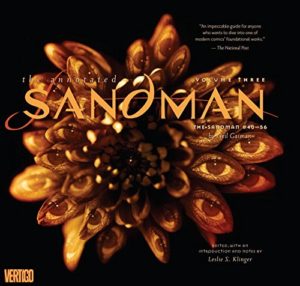
The Annotated Sandman, Vol. 1 (2022 edition)
Annotates issues #1-20
The Annotated Sandman, Vol. 2
Annotates issues #21-39
The Annotated Sandman, Vol. 3
Annotates issues #40-56 & Special and the short story from Vertigo: Winter’s Edge #3.
The Annotated Sandman, Vol. 4
Annotates issues #57-75
The Sandman Companion (1999 hardcover / 2000 paperback)
An issue-by-issue annotation of the series, though this does not collect any of the actual issues of the title.
Hanging Out With the Dream King: Interviews with Neil Gaiman and His Collaborators (2005 paperback)
Sandman Papers An Exploration of the Sandman Mythology (2006 paperback)
A collection of 12 essays discussing Gaiman’s stories and themes.
Other Collections & Appearances
The Sandman Gallery Edition (2015)
Collects reproductions of the original full-size pencil and ink illustrations from The Sandman (1989) #1, The Sandman: The Dream Hunters (2009) #1-4, Vertigo: Winter’s Edge (1998) #2
Dustcovers: The Collected Sandman Covers 1989-1997 (1997 hardcover / 1998 paperback)
Includes “The Last Sandman Story” prose story
Prior to his series in Sandman Mystery Theatre (1993) #1, 12, 22, 25-26 67-68, & 70
Around the start of his series in Swamp Thing (1985) #84 and Hellblazer (1988) #19
During his series in Amazing Heroes Swimsuit Special (1990) #1-3, Books of Magic (1990) #3, Swamp Thing (1985) #118, Ambush Bug Nothing Special (1992) #1, Vertigo Rave (1994) #1, and Vertigo Visions: Prez (1995) #1
After the end of Sandman, Dream appears (in flashback or memory) in The Dreaming (1996) #8, 12, 25, 35, 39, The Girl Who Would Be Death (1998) #1, Neil Gaiman’s Midnight Days (1999), The Sandman Presents: Love Street (1999) #3, The Little Endless Storybook (2001) OGN SC, Mystic (2000) #15, Green Arrow (2001) #9, The Sandman Presents: The Furies (2002) OGN HC, Lucifer (2000) #21, 31, & 75, Death: At Death’s Door (2003) OGN, The Vault of Michael Allred (2006) #1-4, Delirium’s Party: A Little Endless Storybook (2011) OGN, Dark Night: A True Batman Story (2016) OGN, and Doctor Fate (2015) #18
The Sandman: Book of Dreams (1996)
A anthology of short stories edited by Neil Gaiman
The Sandman: Book of Dreams (1996 hardcover / 1997 paperback / 2002 paperback / 2022 paperback)
![]()
The Sandman: The Dream Hunters OGN (1999)
& The Sandman: The Dream Hunters (2009) #1-4 (Jan 2009 – April 2009)
A prose novella written by Gaiman to resemble Japanese folklore and illustrated by Final Fantasy concept illustrator Yoshitaka Amano. This was released as a “eleventh volume” of Sandman, but in story order it occurs (if it “occurs” as such) prior to Overture.
The Sandman: The Dream Hunters OGN (1999 hardcover / 2000 paperback / 2019 30th Anniversary paperback)
Also collected in The Absolute Sandman, Volume Five and Omnibus, Vol. 3, as well as deluxe hardcovers and paperback re-collections, all above.
Later, the same story was adapted to comic form by P. Craig Russell.
(2009) #1-4: The Sandman: The Dream Hunters (2009 hardcover / 2010 paperback / 2019 30th Anniversary paperback)
Also collected in The Absolute Sandman, Volume Five and Omnibus, Vol. 3, as well as deluxe hardcovers and paperback re-collections, all above.
The Sandman: Endless Nights OGN (2003)
An original graphic novel anthology of seven stories of the seven Endless, all written by Neil Gaiman. While some of the tales are set far in the past, Destruction and Delirium’s are both set after the conclusion of Sandman.
The Sandman Endless Nights OGN (2003 hardcover / 2004 paperback / 2013 paperback / 2019 30th Anniversary paperback)
Also collected in The Absolute Sandman, Volume Five and Omnibus, Vol. 3, as well as deluxe hardcovers and paperback re-collections, all above.
The Sandman: Overture (2013) #1-6 (Dec 2013 – Nov 2015)
This 2013 25th anniversary series acts as a prelude to Sandman, explaining how Morpheus wound up in captivity for nearly a century at the start of the series.
While it is set before the series, I wouldn’t suggest reading it first if you have never read Sandman before! However, it makes for a good prologue on re-read, after you already know the character.
The Absolute Sandman: Overture (2023 edition, ISBN 978-1779523525)
Collects The Sandman: Overture (2013) #1-6 in both color and black and white.
#1-6: The Sandman: Overture (2015 deluxe oversize hardcover / 2016 paperback / 2019 30th Anniversary paperback)
Also collected in Omnibus, Vol. 3
Dream States: The Collected Dreaming, Sandman Presents and Overture Covers 1997-2014
Neil Gaiman’s Death of the Endless
Death: The High Cost of Living (1993) #1-3 (Mar – May 1993)
& Death Talks About Life (1994)

Death’s first mini-series began the same month as The Sandman (1989) #47 and told the story of the one day of the century where she walked among mortals.
“Death Talks about Life” was a brief safe(r) sex awareness story originally ran in full in each of Hellblazer (1988) #62, The Sandman (1989) #46, and Shade, the Changing Man (1990) #32. It is routinely collected along with her 1993 mini-series.
The Absolute Death (2020 reprint)
Collects The Sandman (1989) #8 & 20, Death: The High Cost of Living (1993) #1-3, A Death Gallery (1994) #1, Death Talks About Life (1994) #1, Death: The Time of Your Life (1996) #1-3 (and material from the HC collection), The Sandman: Endless Nights (2003) OGN, and material from Vertigo: Winter’s Edge (1998) #2 and 9-11 (2002) OGN Vol. 2
Death: The Deluxe Edition (2012 oversize hardcover / 2022 oversize hardcover / 2014 paperback)
Death: The High Cost of Living (1993 hardcover / 1994 paperback)
Also, issue The High Cost of Living #1 is collected in Vertigo: First Taste (2005). Also collected in Omnibus, Vol. 3.
Death: The Time of Your Life (1996) #1-3 (April – July 1996)
The Absolute Death (2020 reprint)
Collects The Sandman (1989) #8 & 20, Death: The High Cost of Living (1993) #1-3, A Death Gallery (1994) #1, Death Talks About Life (1994) #1, Death: The Time of Your Life (1996) #1-3 (and material from the HC collection), The Sandman: Endless Nights (2003) OGN, and material from Vertigo: Winter’s Edge (1998) #2 and 9-11 (2002) OGN Vol. 2
Death: The Deluxe Edition (2012 oversize hardcover / 2022 oversize hardcover / 2014 paperback)
Death: The Time of Your Life (1996 hardcover / 1997 paperback)
Also collected in Omnibus, Vol. 3.
The Girl Who Would Be Death (1998) #1-4 (Dec 1998 – March 1999)
This series does not actually star Death, but focuses on a girl who finds herself in possession of Death’s lost Ankh necklace.
#1-4: Not collected
Death: At Death’s Door OGN (Sept 2003)
A graphic novel by Jill Thompson set during the events of “Season of Mists.”
Death: At Death’s Door OGN (2003)
This has not since been recollected
The Extended Sandman Universe, 1988 – 2017
The extended world of Sandman has a large crossover with the supporting cast of Hellblazer, and some of these series could be thought of as Hellblazer supporting series as well. See Guide to Hellblazer for more details.
By order of release:
- Black Orchid (1988) #1-3
- Books of Magic – see Books of Magic
- Books of Magic (1990) #1-4
- Mister E (1991) #1-4
- The Children’s Crusade (1993) #1-2
- The Books of Magic (1994) #1-75 (May 1994 – Aug 2000)
- The Books of Faerie Trilogy:
Books of Faerie (1997), Auberon’s Tale (1998), & Molly’s Story (1999) - Names of Magic (2001) #1-5 (Feb – June 2001)
- Hunter: The Age of Magic (2001) #1-25 (Sept 2001 – Sept 2003)
- Books of Magick: Life During Wartime (2004) #1-15 (Sept 2004 – Dec 2005)
- Black Orchid (1993) #1-22 & Annual 1
- WitchCraft (1994) #1-3
- Destiny: A Chronicle of Deaths Foretold (1996) #1-3
- The Dreaming (1996) #1-60 (June 1996 – May 2001)
& The Dreaming: Trial and Error Special - WitchCraft: La Terreur (1998) #1-3
- Lucifer – see Lucifer
- The Sandman Presents: Lucifer (1999) #1-3
- Lucifer (2000) #1- (June 2000 – Aug 2006)
& Lucifer: Nirvana OGN (2002) - Lucifer (2016)
- The Sandman Presents: Love Street (1999) #1-3
- Merv Pumpkinhead, Agent of D.R.E.A.M. OGN (2000)
- The Sandman Presents: Petrefax (2000) #1-4
- The Sandman Presents: Everything You Always Wanted to Know About Dreams…But Were Afraid to Ask (2001) #1
- The Sandman Presents: Dead Boy Detectives (2001) #1-4
- The Little Endless Storybook (2001)
& Delirium’s Party: A Little Endless Storybook (2011) - The Sandman Presents: The Corinthian (2001) #1-3
- The Sandman Presents: The Furies OGN (2002)
- The Sandman Presents: The Thessaliad (2002) #1-4
- The Sandman Presents: Bast (2003) #1-3
- The Witching (2004) #1-10
- The Sandman Presents: Thessaly: Witch for Hire (2004) #1-4
- The Dead Boy Detectives OGN (2005)
- Dead Boy Detectives (2014) #1-12
Black Orchid (1988) #1-3 (Nov 1988 – Jan 1989)
While Neil Gaiman’s original series for DC is not explicitly tied to Sandman, it is the prototype of him reinventing a Bronze Age hero for an adult audience. Also, the subsequent volume connects to “The Children’s Crusade,” which is a part of Books of Magic, which is part of the extended Sandman Universe!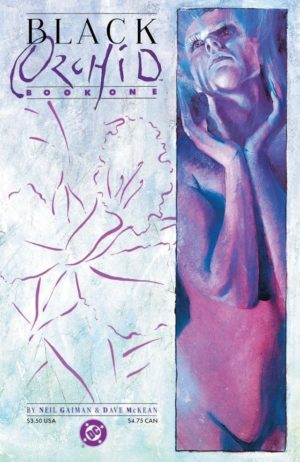
#1-3: Black Orchid (1993 paperback / deluxe oversize hardcover 2012 / 2013 deluxe paperback)
Black Orchid (1993) #1-22 & Annual 1 (Sept 1993 – June 1995)
#1-4: Not collected
#5: Not collected; “The Mind Fields,” crossover to Swamp Thing (1985) #139
#6-16: Not collected
#17-22: Not collected; “A Twisted Season”
Annual 1: Not collected; part of “Children’s Crusade”
WitchCraft (1994)
A story of The Furies from James Robinson.
#1-4: Witchcraft (1994 paperback)
Destiny: A Chronicle of Deaths Foretold (1996)
#1-3: Destiny: A Chronicle of Deaths Foretold
The Dreaming (1996) #1-60 (June 1996 – May 2001)
& The Dreaming: Trial and Error Special
Moreso than any other book in the extended Sandman Universe, this series is the direct continuation of Gaiman’s run. It extends the story of his kingdom of dreams and its oddball cast, like Cain, Abel, Muriel, Brian, Merv, Eve, and more. Note that issue #8 contains additional story pages for The Sandman (1989) #72, and is collected thoroughly along with that story, above.
#1-8: Vol. 1: Beyond the Shores of Night
#9-12: Not collected; “Weird Romance”
#13-14: Not collected; “Coyote’s Kiss”
#15-19 & 22-25: Vol 2: Through the Gates of Horn and Ivory (1999 paperback)
#20-21: Not collected; “Tears for a Dark Rose”
#26, Special, & 27-34: Not collected; “Many Mansions.” The Special was released between #25-26, but fits between #26-27.
#35: Not collected
#36-38: Not collected; “The Gyres”
#39: Not collected
#40-43: Not collected; “Fox and Hounds”
#44-49: Not collected; “Trinket”
#50-51: Not collected
#52-54: Not collected; “Exiles”
#55: Collected in both Bad Doings and Big Ideas: A Bill Willingham Deluxe Edition (2011 hardcover) and The Sandman Presents: Taller Tales (2003 paperback)
#56: Not collected; “The Further Adventures of…”
#57-60: Not collected; “Rise”
Dream States: The Collected Dreaming, Sandman Presents and Overture Covers 1997-2014
WitchCraft: La Terreur (1998)
A story of The Furies from James Robinson and Michael Zulli.
#1-3: Not collected
The Sandman Presents: Love Street (1999) #1-3 (July – Sept 1999)
#1-3: Not collected
Merv Pumpkinhead, Agent of D.R.E.A.M. OGN (2000)
Merv Pumpkinhead, Agent of D.R.E.A.M. OGN (2000)
Recollected in both Bad Doings and Big Ideas: A Bill Willingham Deluxe Edition (2011 hardcover) and The Sandman Presents: Taller Tales (2003 paperback)
The Sandman Presents: Petrefax (2000) #1-4 (Mar – June (2000)
Written by Lucifer‘s Mike Carey.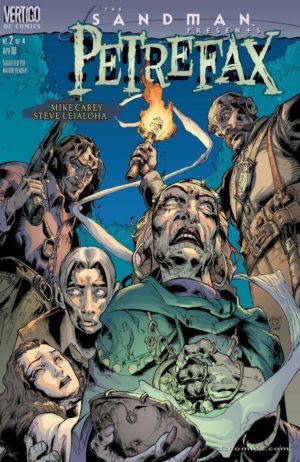
#1-4: Vertigo Resurrected: The Sandman Presents – Petrefax (2011)
The Sandman Presents: Everything You Always Wanted to
Know About Dreams… But Were Afraid to Ask (July 2001)
Written by Bill Willingham of Fables.
#1: in both Bad Doings and Big Ideas: A Bill Willingham Deluxe Edition (2011 hardcover) and The Sandman Presents: Taller Tales (2003 paperback)
The Sandman Presents: Dead Boy Detectives (2001) #1-4 (Aug – Nov 2001)
Written by Ed Brubaker.
in omnibus oversize hardcover…
Dead Boy Detectives Omnibus (Sandman Universe Classics)
(2023 oversize hardcover, ISBN 978-1779524522)
Collects The Sandman (1988) #25, The Children’s Crusade (1993) #1-2 (plus material from Doom Patrol (1987) Annual 2, Swamp Thing (1985) Annual 7, and new material from Free Country: A Tale of the Children’s Crusade (2017) trade paperback), a story from Vertigo: Winter’s Edge (1997) #3, The Sandman Presents: The Dead Boy Detectives #1 (2001) #1-4, material from Death: At Death’s Door (2003) OGN, The Dead Boy Detectives (2005) OGN the serialized “Run Ragged” story (from Ghosts (2012) #1, Time Warp (2013) #1, and The Witching Hour (2013) #1), Dead Boy Detectives (2014) #1-12.
as originally collected…
#1-4: The Sandman Presents: Dead Boy Detectives (2008 paperback)
The Little Endless Storybook (2001)
& Delirium’s Party: A Little Endless Storybook (2011)
A pair of children’s books of The Endless from Jill Thompson, focusing on Delirium.
as recollected in a 2024 box set…
Little Endless Storybook Box Set
(2024 paperback box set, ISBN 978-1779525529)
as individually released…
The Little Endless Storybook (2001 paperback / 2004 hardcover)
Delirium’s Party: A Little Endless Storybook (2011 hardcover)
The Sandman Presents: The Corinthian (2001) #1-3 (Dec 2001 – Feb 2002)
 Writer Darko Macan expands the story of The Corinthian from “The Kindly Ones,” as set in the 1920s.
Writer Darko Macan expands the story of The Corinthian from “The Kindly Ones,” as set in the 1920s.
#1-3: Not collected
The Sandman Presents: The Furies OGN (2002)
Written by Lucifer’s Mike Carey.
The Sandman Presents: The Furies OGN (2002 hardcover / 2003 paperback)
The Sandman Presents: The Thessaliad (2002) #1-4 (March – June 2002)
Written by Bill Willingham of Fables.
#1-4: in both Bad Doings and Big Ideas: A Bill Willingham Deluxe Edition (2011 hardcover) and The Sandman Presents: Taller Tales (2003 paperback)
The Sandman Presents: Bast (2003) #1-3 (March – May 2003)
#1-3: Not collected
The Witching (2004) #1-10 (Aug 2004 – May 2005)
Lucifer appears in three issues of this series written by Jonathan Vankin.
#1-10: Not collected
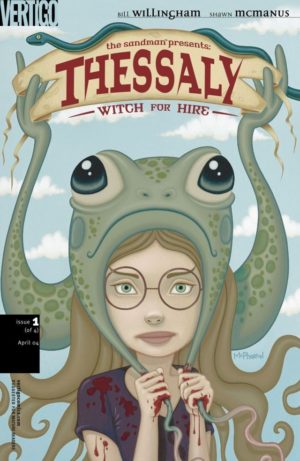
The Sandman Presents:
Thessaly – Witch for Hire (2004) #1-4 (April – July 2004)
Written by Bill Willingham of Fables.
#1-4: The Sandman Presents: Thessaly, Witch for Hire
The Dead Boy Detectives OGN (2005)
An OGN by Jill Thompson.
in omnibus oversize hardcover…
Dead Boy Detectives Omnibus (Sandman Universe Classics)
(2023 oversize hardcover, ISBN 978-1779524522)
Collects The Sandman (1988) #25, The Children’s Crusade (1993) #1-2 (plus material from Doom Patrol (1987) Annual 2, Swamp Thing (1985) Annual 7, and new material from Free Country: A Tale of the Children’s Crusade (2017) trade paperback), a story from Vertigo: Winter’s Edge (1997) #3, The Sandman Presents: The Dead Boy Detectives #1 (2001) #1-4, material from Death: At Death’s Door (2003) OGN, The Dead Boy Detectives (2005) OGN the serialized “Run Ragged” story (from Ghosts (2012) #1, Time Warp (2013) #1, and The Witching Hour (2013) #1), Dead Boy Detectives (2014) #1-12.
as originally collected…
Dead Boy Detectives (2014) #1-12 (Feb 2014 – Feb 2015)
Co-written and pencilled by Mark Buckingham.
in omnibus oversize hardcover…
Dead Boy Detectives Omnibus (Sandman Universe Classics)
(2023 oversize hardcover, ISBN 978-1779524522)
Collects The Sandman (1988) #25, The Children’s Crusade (1993) #1-2 (plus material from Doom Patrol (1987) Annual 2, Swamp Thing (1985) Annual 7, and new material from Free Country: A Tale of the Children’s Crusade (2017) trade paperback), a story from Vertigo: Winter’s Edge (1997) #3, The Sandman Presents: The Dead Boy Detectives #1 (2001) #1-4, material from Death: At Death’s Door (2003) OGN, The Dead Boy Detectives (2005) OGN the serialized “Run Ragged” story (from Ghosts (2012) #1, Time Warp (2013) #1, and The Witching Hour (2013) #1), Dead Boy Detectives (2014) #1-12.
as originally collected…
#1-6: Vol. 1: School Boy Terrors
Also collects a three-part Dead Boy Detectives story from anthology titles Ghosts (2012) #1, Time Warp (2013) #1, and The Witching Hour (2013) #1.
#7-12: Vol. 2: Ghost Snow
The Sandman Universe (2018 – present)
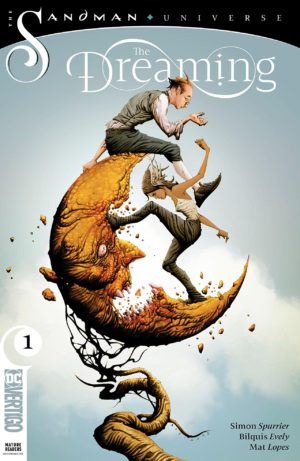
After over a decade of absence, Daniel Hall turned up (with Neil Gaiman’s blessing) in Dark Nights: Metal (2017) #1-2 & 4 as a guiding spirit for Batman on his quest.
Then, in August of 2018, a one-shot – The Sandman Universe – launched a quartet of additional series – The Dreaming, House of Whispers, a resurrection of Books of Magic, and a new volume of Lucifer.
The Dreaming (2018) #1-20
#1-6: Vol. 1: Pathways and Emanations (2019 paperback)
Also collects Sandman Universe #1
#7-12: Vol. 2: Empty Shells (2020 paperback, ISBN 978-1401295639)
#13-20: Vol. 3: One Magical Movement (2020 paperback, ISBN 978-1779502834)
Locke & Key / The Sandman Universe: Hell & Gone (2020) #0-3
A Gaiman-sanctioned crossover with Joe Hill’s Locke & Key. Note that issue #0 is entirely reprinted material.
Locke & Key: The Golden Age (2022 hardcover, ISBN 978-1684057856 / digital)
Collects Locke & Key / The Sandman Universe: Hell & Gone (2020) #0-3, Locke & Key: In Pale Battalions Go (2020) #1-3, and Locke & Key: Small World (2016) #1. Also collected in Locke & Key Master Edition Vol. 4 oversize hardcover.
The Dreaming: Waking Hours (2020) #1-12
Written by Ms. Marvel creator G. Willow Wilson, this focuses on Shakespeare, the Faerie Court, and the Dreaming at large. [Ed. Note: This was my favorite comic for most of its run – terrific stuff, and so lovely!]
#1-12: The Dreaming: Walking Hours (2021 paperback, ISBN 978-1779512734/ digital)
The Sandman Universe: The Dead Boy Detectives (2022) #1-6
Written by indie comics rising star Pornsak Pichetshote.
#1-6: Dead Boy Detectives (2023 paperback, ISBN 978-1779523297 / digital)
Sandman Universe: Nightmare Country (2022) #1-6,
The Sandman Universe Special: Thessaly (2023) #1,
& The Sandman Universe: Nightmare Country, The Glass House (2023) #1-6
Written by comics superstar James Tynion IV, these comics focus on nightmares including The Corinthian, released alongside the Netflix adaptation.
#1-6: Nightmare Country, Vol. 1 (2023 hardcover, ISBN 978-1779518415 / 2024 paperback, ISBN / digital)
The Sandman Universe Special: Thessaly (2023) #1 &
The Glass House (2023) #1-6: Nightmare Country Vol. 2: The Glass House (2024 hardcover, ISBN 978-1779520722 / digital)
Didn’t find what you were looking for?
Check Amazon for DC’s newest Sandman and The Dreaming comics
